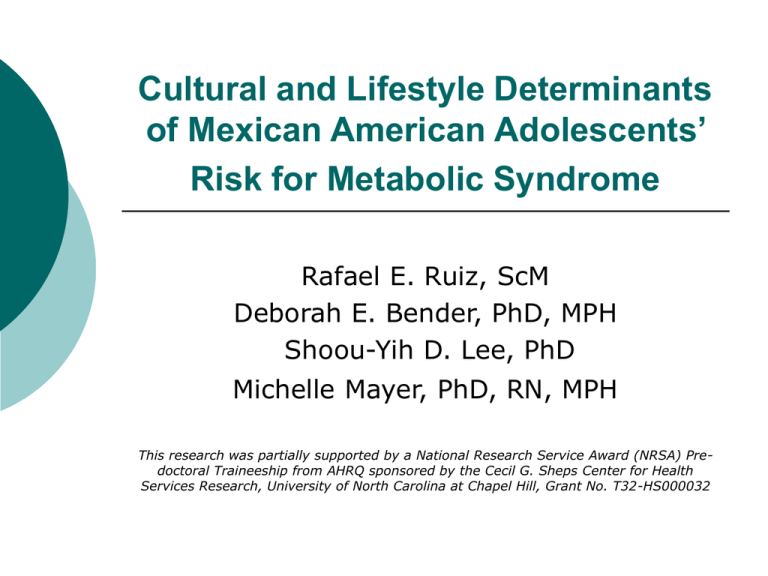Cultural and Lifestyle Determinants of Mexican American Adolescents’ Risk for Metabolic Syndrome
advertisement

Cultural and Lifestyle Determinants of Mexican American Adolescents’ Risk for Metabolic Syndrome Rafael E. Ruiz, ScM Deborah E. Bender, PhD, MPH Shoou-Yih D. Lee, PhD Michelle Mayer, PhD, RN, MPH This research was partially supported by a National Research Service Award (NRSA) Predoctoral Traineeship from AHRQ sponsored by the Cecil G. Sheps Center for Health Services Research, University of North Carolina at Chapel Hill, Grant No. T32-HS000032 Introduction “Latino/Hispanic” is used by CDC to generically describe Spanish speaking individuals The Latino population is young The majority are of Mexican descent (~60%) and growing rapidly Acculturation is a socio-cultural construct that captures the degree which a person integrates the social values, beliefs, and lifestyle of the dominant culture Introduction Overweight and type-2 diabetes have both increased in adolescents Metabolic syndrome affects adults (22%) and adolescents (4.2%) Mexican Americans have been shown to have higher rates of metabolic syndrome Conceptual Model Physical Activity Metabolic Syndrome Acculturation Diet Overweight Type-2 Diabetes CVD Specific Aims 1) Determine if metabolic syndrome, physical activity, and diet differ among racial/ethnic groups 2) Explore the association of physical activity and diet with metabolic syndrome 3) Examine the association of acculturation with metabolic syndrome, physical activity, and diet in Mexican Americans Data National Health and Nutrition Examination Survey (NHANES) 1999-2002 Pooled cross-section Analytic dataset restrictions (N=2,002) adolescents, 12-19 years of age, with a fasting plasma glucose level not taking insulin, oral hypoglycemic agents, and not pregnant Variables In adolescents, three or more of the following traits define metabolic syndrome Criterion Measurement Elevated triglycerides 110 mg/dl Low HDL 40 mg/dl Increased waist circumference 90th percentile (cm) Elevated fasting glucose 110 mg/dl Elevated blood pressure 90th percentile (mm Hg) Cook S, et al. Prevalence of a metabolic syndrome phenotype in adolescents: findings from the third National Health and Nutrition Examination Survey, 1988-1994. Arch Pediatr Adolesc Med 2003 Sep;157(8):821-827 Variables Primary language was used to measure acculturation read or spoken used as a child usually spoken at home usually used to think usually spoken with friends Physical activity Discrete: None vs. any Continuous: Number, frequency, duration, and intensity Variables Dietary measures Variability: number of foods eaten/day Frequency of eating out: number of restaurants meals/wk Energy: total calories consumed Total macronutrients: protein (gm), sugars (gm), cholesterol (mg), and fat (gm) Statistical Methods Bivariate associations Multivariate analysis Logistic regression Dependent variable: having metabolic syndrome Independent variable of interest: acculturation OLS regression Dependent variables: Physical activity and dietary measures Independent variable of interest: acculturation Prevalence of Metabolic Syndrome 50.0 Metabolic syndrome traits in US adolescents with metabolic syndrome Percent of Subjects 45.0 40.0 Prevalence of metabolic syndrome was 4.8% 35.0 30.0 25.0 20.0 15.0 10.0 5.0 0.0 Elevated Triglycerides Low HDL Abdominal Adiposity Elevated Fasting Plasma Glucose Metabolic Syndrome Traits Elevated Blood Pressure Inactive (8.9%*) vs. active (4.1%) Low variability in diet (8.9%*) vs. higher variability (4.1%) Males (6.6%*) vs. females (2.9%) Overweight (25%**) vs. not-overweight (0.5%) *-significant at 5% level, **-significant at 1% level Differences among groups Prevalence of metabolic syndrome in US adolescents by race/ethnicity 9.0 Percent of Subjects 8.0 * Mexican Americans were more likely to... 7.0 6.0 5.0 4.0 3.0 2.0 1.0 0.0 Mexican American Caucasian Race/Ethnicity African American be inactive (19%*) vs. non-Latinos (14%) Be overweight (22%*) vs. nonLatinos (17%) Mexican American males (25%*) were more likely than females (18%) to be overweight *-significant at 5% level Associations with metabolic syndrome Inactivity increases risk of metabolic syndrome (OR: 4.68, CI: 1.83-11.93) Greater dietary variability decreases risk of metabolic syndrome (OR: 0.85, CI: 0.73-0.98) Acculturation does not directly affect metabolic syndrome (OR: 1.52, CI: 0.78-2.97) Acculturation, physical activity, diet Higher levels of acculturation decrease inactivity [OR-0.65 (0.48-0.88)] Higher levels of acculturation increase # of physical activities (+0.41/month**) energy (137 kcal/day*) carbohydrates (+25 gm/day**) saturated fat (+2 gm/day*) # of times at restaurant food (+0.3 times/week*) Summary Mexican American males are the most likely to develop metabolic syndrome Higher likelihood of overweight, less physical activity, and fewer types of foods eaten A higher level of acculturation increases overweight increases intake of calories, carbohydrates, saturated fat, and more meals eaten outside the home increases physical activity, BUT it seems to be a weak effect Significance Acculturation and metabolic syndrome have an indirect association It is a risk factor in Mexican American adolescents Underscores the importance of reducing adolescent overweight increasing physical activity promoting healthy dietary options Considerations There is no consensus on how to define metabolic syndrome in adolescents operationalize acculturation Time in the U.S. was not a component of acculturation Primary language spoken has been shown to be a good indicator of acculturation Language skills are acquired over time so they are linked to the time spent in the U.S.






